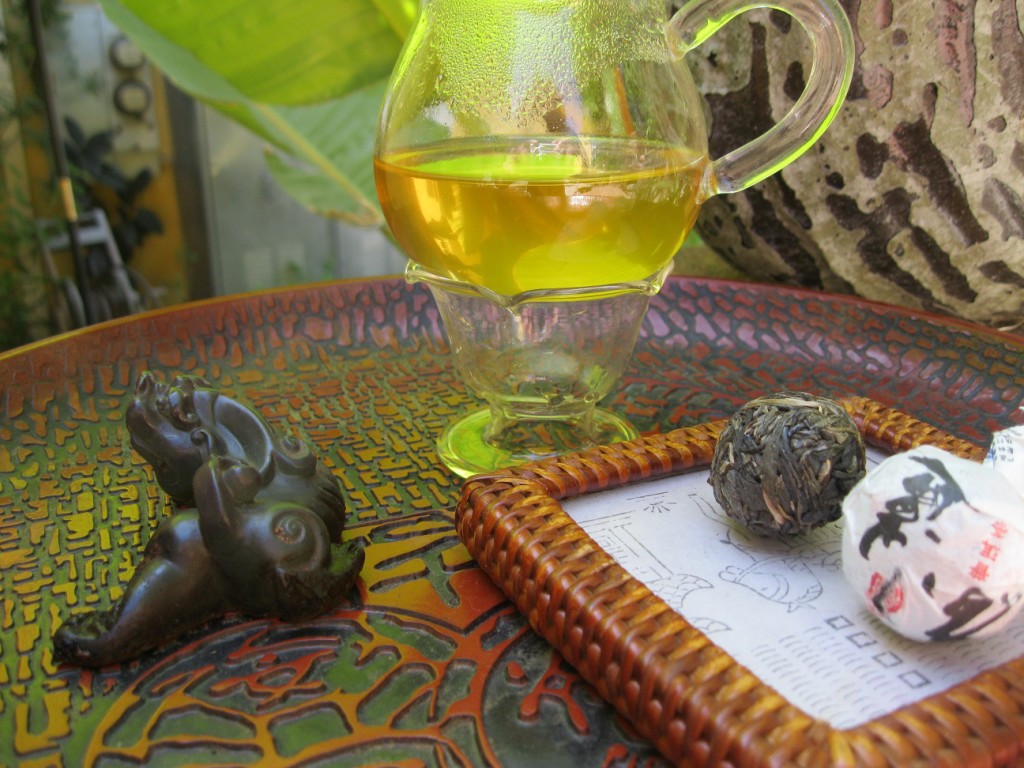How to Brew Ripe Pu erh

In this missive, we’ll discuss the brewing of ripe pu erh tea. Simple enough, but first some background.
pu erh tea is slowly gaining traction in the Western consciousness. It seems to appeal to two types, connoisseurs and the health-oriented. Connoisseurs like pu erh for the same reasons that they are drawn to finer wines and cigars. It’s been likened to the champagne of tea, probably due to its increasing value with age. The taste, well sometimes like that stinky cheese you feel guilty about liking and other times like orchid bliss, depends on many factors that fascinates the collector tastes and smells. Health-enthusiasts not only like its undiscovered appeal but also what it does for them health-wise.
Pu erh comes in two forms, raw and ripe. They differ in how they are processed. Raw pu erh is less processed making it similar to green tea and ripe pu erh is processed in a way making it similar to black tea. Aged raw pu erh undergoes slow oxidation and ripe pu erh undergoes expedited oxidation with probiotic cultures that are key to its function as a digestive aid. It is primarily these cultures that make ripe pu erh highly desirable among those interested in optimizing health and losing weight.
There are a few ways in which pu erh can be brewed. They loosely fall into two categories: brewing for taste and brewing for health. This is not to say that brewing for health tastes bad. It is only that when brewing for taste more ritual is involved, nuance takes priority over extracting all of the nutrients sought after by the health-optimizer.
Connoisseur drinking involves multiple infusions of short duration. It involves more teaware, such as a gaiwan or pot for brewing and a pitcher for collecting the brew. In ye olde English type tea drinking, tea is thrown into a pot, steeped for a few minutes and poured into a tea cup where milk and sugar are added. The connoisseur of pu erh shutters at the mention of milk. The objective is to appreciate the layers of nuance expressed in each infusion… and it’s a feature far more emphasized with raw pu erh.
Brewing ripe pu erh for health purposes is easy, either by brewing or boiling. Probably most important is brew time, which should be at least five minutes. What I like to do is place my brew in a thermos and let it sit for at least 10 minutes before taking my first cup. I will drink from this same thermos throughout the day. There is no concern about it becoming too bitter, because the fermentation factor essentially transforms the tannins, much like a finer red wine does when left to age or breathe. This said, it is good to remember that older ripe pu erhs will be less tannic than younger ones and fermentation degrees vary by production and storage methods.
My thermos holds 16oz and this produces a very dark brew with 10g of ripe pu erh, probably too dark, as I always end up adding at least another 8oz. It’s my feeling that you want to have the brew thick and rich for health purposes, but there’s not basis for this opinion other than concentration usually being a factor in an herb’s efficacy. Puer’s density will be what you determine it to be, but you want it dilute enough so that all the good stuff can release into the water. A general rule of thumb is two oz of water to every gram of ripe pu erh. It you want to add some rose petals, osmanthus flowers, a bit of orange-peel or ginger, that’s perfectly fine, so is some honey, ghee, or coconut oil.
Let’s rap it up. pu erh is a branching rabbit hole that has something for everyone who enjoys exploring life’s little miracles. Knowing the way to brew it might seem intimidating. Above, your humble pu erh Junky gave a lay of the pu erh landscape. Some of this included the finer points of pu erh’s taste in relation to its fermentation. Brewing pu erh for health is really simple. I’m particularly fond of my 16oz thermos. Boiling will extract lots but a thermos works nearly as well. Plus, you don’t have to spend time over a stove.
Get a thermos already!
